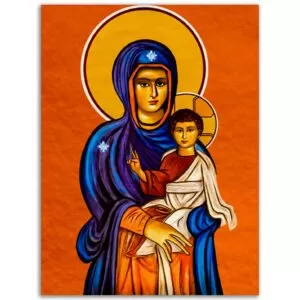SAINT CECILIA
Virgin and martyr, patroness of church music, died at Rome. This saint, so often glorified in the fine arts and in poetry, is one of the most venerated martyrs of Christian antiquity. The oldest historical account of St. Cecilia is found in the “Martyrologium Hieronymianum”; from this it is evident that her feast was celebrated in the Roman Church in the fourth century. Her name occurs under different dates in the above-mentioned martyrology; its mention under 11
August, the feast of the martyr Tiburtius, is evidently a later and erroneous addition, due to the fact that this Tiburtius, who was buried on the Via Labicana, was wrongly identified with Tiburtius, the brother-in-law of St. Cecilia, mentioned in the Acts of her martyrdom. Perhaps also there was another Roman martyr of the name of Cecilia buried on the Via Labicana. Under the date of 16 September Cecilia is mentioned alone, with the topographical note: “Appiâ viâ in eâdem urbe Româ natale et passio sanctæ Ceciliæ virginis (the text is to be thus corrected). This is evidently the day of the burial of the holy martyr in the Catacomb of Callistus. The feast of the saint mentioned under 22 November, on which day it is still celebrated, was kept in the church in the Trastevere quarter at Rome, dedicated to her. Its origin, therefore, is to be traced most probably to this church. The early medieval guides (Itineraria) to the burial-places of Roman martyrs point out her grave on the Via Appia, next to the crypt of the Roman bishops of the third century (De Rossi, Roma sotterranea, I, 180-181). De Rossi located the burial-place of
Cecilia in the Catacomb of Callistus in a crypt immediately adjoining the crypt or chapel of the popes; an empty niche in one of the walls contained, probably, at one time the sarcophagus with the bones of the saint. Among the frescoes of a later time with which the wall of the sepulchre are adorned, the figure of a richly dressed woman appears twice and Pope Urban, who was brought personal into close relation with the saint by the Acts of her martyrdom, is depicted
once. The ancient titular church of Rome, mentioned above was built as early as the fourth century and is still preserved in the Trastevere. This church was certainly dedicated in the fifth century to the saint buried on the Via Appia; it is mentioned in the signatures of the Roman Council of 499 as “titulus sanctae Caeciliae”. Like some other ancient Christian churches of Rome, which are the gifts of the saints whose names they bear, it may be inferred that the Roman Church owes this temple to the generosity of the holy martyr herself; in support of this view it is to be noted that the property, under which the oldest part of the true Catacomb of Callistus is constructed, belonged most likely, according to De Rossi’s researches, to the
family of St. Cecilia, and by donation passed into the possession of the Roman Church. Although her name is not mentioned in the earliest (fourth century) list of feasts (Depositio martyrum), the fact that in the “Sacramentarium Leoniam”, a collection of masses completed about the end of
the fifth century, are found no less than five different masses in honour of St. Cecilia testifies to the great veneration in which the saint was at that time held in the Roman Church.
About the middle of the fifth century originated Acts of the martyrdom of St. Cecilia which have been transmitted in numerous manuscripts; these acts were also translated into Greek. They were utilized in the prefaces of the above mentioned masses of the “Sacramentarium Leonianum”. They inform us, that Cecilia, a virgin of a senatorial family and a Christian from her infancy, was given in marriage by her parents to a noble pagan youth Valerianus. When, after
the celebration of the marriage, the couple had retired to the wedding-chamber, Cecilia told Valerianus that she was betrothed to an angel who jealously guarded her body; therefore Valerianus must take care not to violate her virginity. Valerianus wished to see the angel, whereupon Cecilia sent him to the third milestone on the Via Appia where he should meet Bishop (Pope) Urbanus. Valerianus obeyed, was baptized by the pope, and returned a Christian to
Cecilia. An angel then appeared to the two and crowned them with roses and lilies. When Tiburtius, the brother of Valerianus, came to them, he too was won over to Christianity. As zealous children of the Faith both brothers distributed rich alms and buried the bodies of the confessors who had died for Christ. The prefect, Turcius Almachius, condemned them to death; an officer of the prefect, Maximus, appointed to execute this sentence, was himself converted and suffered martyrdom with the two brothers. Their remains were buried in one tomb by
Cecilia. And now Cecilia herself was sought by the officers of the prefect. Before she was taken prisoner, she arranged that her house should be preserved as a place of worship for the Roman Church. After a glorious profession of faith, she was condemned to be suffocated in the bath of her own house. But as she remained unhurt in the overheated room, the prefect had her decapitated in that place. The executioner let his sword fall three times without separating
the head from the trunk, and fled, leaving the virgin bathed in her own blood. She lived three days, made dispositions in favour of the poor, and provided that after her death her house should be dedicated as a church. Urbanus buried her among the bishops and the confessors, i.e. in the Catacomb of Callistus.
In this shape the whole story has no historical value; it is a pious romance, like so many others compiled in the fifth and sixth century. The existence of the aforesaid martyrs, however, is a historical fact. The relation between St. Cecilia and Valerianus, Tiburtius, and Maximus, mentioned in the Acts, has perhaps some historical foundation. These three saints were buried in the Catacomb of Praetextatus on the Via Appia, where their tombs are mentioned in the ancient pilgrim Itineraria. In the “Martyrologium Hieronymianum” their feast is set down under 14 April with the note: “Romae via Appia in cimiterio Prætextati”; and the octave under 21 April, with the comment: “Rome in cimiterio Calesti via Appia”. In the opinion of Duchesne the octave was
celebrated in the Catacomb of Callistus, because St. Cecilia was buried there. If, therefore, this second notice in the martyrology is older than the aforesaid Acts, and the latter did not give rise to this second feast, it follows that before the Acts were written this group of saints in Rome was brought into relation with St. Cecilia. The time when Cecilia suffered martyrdom is not known. From the mention of Urbanus nothing can be concluded as to the time of composition of the Acts; the author without any authority, simply introduced the confessor of this name (buried in the Catacomb of Praetextatus) on account of the nearness of his tomb to those of the other martyrs and identified him with the pope of the same name. The author of the “Liber Pontificalis” used the Acts for his notice of Urbanus. The Acts offer no other indication of the time of the martyrdom. Venantius Fortunatus (Miscellanea, 1, 20; 8,6) and Ado (Martyrology, 22 November) place the death of the saint in the reign of Marcus Aurelius and Commodus (about 177), and De Rossi tried to prove this view as historically the surest one. In other Western sources of the early Middle Ages and in the Greek “Synaxaria” this martyrdom is placed in the persecution of Diocletian. P.A.
Kirsch tried to locate it in the time of Alexander Severus; Aubé, in the persecution of Decius; Kellner, in that of Julian the Apostate. None of these opinion is sufficiently established, as neither the Acts nor the other sources offer the requisite chronological evidence. The only sure time-indication is the position of the tomb in the Catacomb of Callistus, in the immediate proximity of the very ancient crypt of the popes, in which Urbanus probably, and surely Pontianus and Anterus were buried. The earliest part of this catacomb dates at all events from the end of the second century; from that time, therefore, to the middle of the third century is the period left open for the martyrdom of St. Cecilia.
Her church in the Trastevere quarter of Rome was rebuilt by Paschal I, on which occasion the pope wished to transfer thither her relics; at first, however, he could not find them and believed that they had been stolen by the Lombards. In a vision he saw St. Cecilia, who exhorted him to continue his search, as he had already been very near to her, i.e. near her grave. He therefore renewed his quest; and soon the body of the martyr, draped in costly stuffs of gold brocade and with the cloths soaked in her blood at her feet, was actually found in the Catacomb of Prætextatus. They may have been transported thither from the Catacomb of Callistus to save them from earlier depredations of the Lombards in the vicinity of Rome. The relics of St. Cecilia with those of Valerianus, Tiburtius, and Maximus, also those of Popes Urbanus and Lucius, were
taken up by Pope Paschal, and reburied under the high altar of St Cecilia in Trastevere. The monks of a convent founded in the neighbourhood by the same pope were charged with the duty of singing the daily Office in this basilica. From this time the veneration of the holy martyr continued to spread, and numerous churches were dedicated to her. During the restoration of the church in the year 1599 Cardinal Sfondrato had the high altar examined and found under it the sarcophagi, with the relics of the saints, that Pope Paschal had transported thither. Recent excavations beneath the church, executed at the instigation and expense of Cardinal Rampolla, disclosed remains of Roman buildings, which have remained accessible. A richly adorned underground chapel was built beneath the middle aisle, and in it a latticed window, opening over the altar, allows a view of the receptacles in which the bones of the saints repose. In a side chapel of the church there have long been shown the remains of the bath in which, according to the Acts, Cecilia was put to death.
The oldest representations of St. Cecilia show her in the attitude usual for martyrs in the Christian art of the earlier centuries, either with the crown of martyrdom in her hand (e.g. at S. Apollinare Nuovo in Ravenna, in a sixth-century mosaic) or in the attitude of prayer, as an Orans (e.g. the two sixth and seventh-century pictures in her crypt). In the apse of her church in Trastevere is still preserved the mosaic made under Pope Paschal, wherein she
is represented in rich garments as patroness of the pope. Medieval pictures of the saint are very frequent; since the fourteenth and fifteenth centuries she is given the organ as an attribute, or is represented as playing on the organ, evidently to express what was often attributed to her in panegyrics and poems based on the Acts, viz., that while the musicians played at her nuptials she
sang in her heart to God only (“cantantibus organis illa in corde suo soi domino decantabat”); possibly the cantantibus organis was erroneously interpreted of Cecilia herself as the organist. In this way the saint was brought into closer relation with music. When the Academy of Music was founded at Rome (1584) she was made patroness of the institute, whereupon her veneration as patroness of church music in general became still more universal; today
Cecilian societies (musical associations) exist everywhere. The organ is now her ordinary attribute; with it Cecilia was represented by Raphael in a famous picture preserved at Bologna. In another magnificent masterpiece, the marble statute beneath the high altar of the above-mentioned church of St. Cecilia at Rome, Carlo Maderna represented her lying prostrate, just as she had received the death-blow from the executioner’s hand. Her feast is celebrated in the Latin
and the Greek Church on 22 November. In the “Martyrologium Hieronymainum” are commemorated other martyrs of this name, but of none of them is there any exact
historical information. One suffered martyrdom in Carthage with Dativus in 304.
rosary.team






















